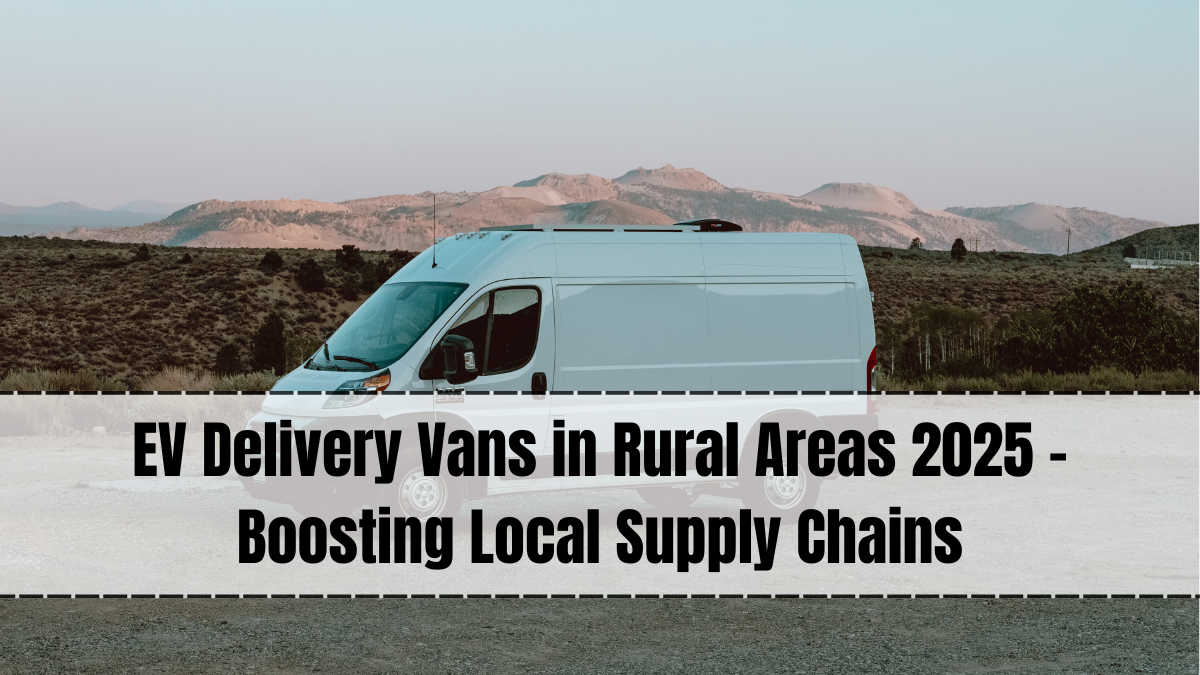The rise of EV delivery vans rural 2025 is reshaping how goods are transported in India’s villages and small towns. By integrating electric logistics into rural supply networks, these vehicles are improving efficiency, reducing costs, and cutting carbon emissions. The shift towards sustainable transport in rural regions is not only an environmental win but also an economic boost for local businesses.
In the past, rural delivery systems relied heavily on diesel-powered vehicles, which were costly to operate and maintain. Now, thanks to advancements in electric vehicle technology, government incentives, and better charging infrastructure, electric vans are becoming the go-to choice for rural logistics providers.

Why EV Delivery Vans Are Essential for Rural Areas
The adoption of EV delivery vans rural 2025 is being driven by several key factors:
-
Rising Fuel Costs – Electricity offers a cheaper and more stable energy source compared to diesel.
-
Government Subsidies – Incentives for electric logistics make vehicles more affordable for transport businesses.
-
Environmental Benefits – Zero tailpipe emissions help reduce air pollution in rural communities.
-
Improved Technology – Better batteries, longer range, and faster charging have made electric vans a viable choice for longer rural routes.
This transition to green transport ensures that rural supply chains become more sustainable and cost-efficient.
How Electric Logistics Strengthens Rural Supply Chains
In rural India, supply chains often face challenges like poor road connectivity, long delivery times, and high transportation costs. EV delivery vans are helping to overcome these obstacles by:
-
Reducing Operating Costs – Electricity is cheaper than diesel, and maintenance is simpler.
-
Enabling Last-Mile Delivery – Smaller, agile vans can reach remote villages more easily.
-
Boosting Local Businesses – Faster deliveries mean farmers, artisans, and shopkeepers can serve their customers more effectively.
-
Improving Reliability – Electric drivetrains require less maintenance, reducing breakdowns and delays.
Government Policies Supporting EV Delivery Vans in 2025
The Indian government’s push towards green transport has led to a range of supportive measures:
-
Purchase Subsidies – Financial incentives reduce the upfront cost of electric vans.
-
Low-Interest Loans – Special schemes for logistics businesses investing in EVs.
-
Charging Station Expansion – Rural charging infrastructure is rapidly growing, making it easier to operate electric logistics fleets.
-
Tax Benefits – Reduced GST and road tax exemptions for EV owners.
These initiatives aim to accelerate the adoption of EV delivery vans rural 2025 across all sectors of rural supply chains.
Benefits for Rural Communities
The switch to electric logistics is creating a positive ripple effect in rural areas:
-
Cleaner Air – Reduced emissions improve public health.
-
Lower Delivery Costs – Savings can be passed on to customers.
-
Job Creation – Demand for EV drivers, charging station staff, and maintenance workers.
-
Energy Independence – Potential integration with solar-powered charging stations.
By embracing green transport, rural India is taking a step towards both economic and environmental sustainability.
Challenges in Adopting EV Delivery Vans
Despite the benefits, certain challenges remain:
-
High Initial Cost – Even with subsidies, electric vans are still more expensive than traditional options.
-
Limited Charging Infrastructure – While improving, some remote areas still lack charging stations.
-
Awareness and Training Gaps – Drivers and logistics operators need training to adapt to EV usage.
Addressing these issues will be crucial to ensuring that EV delivery vans rural 2025 can be widely adopted.
The Future of Rural Electric Logistics
The future of electric logistics in rural India looks promising. As technology becomes more affordable, and green transport policies continue to strengthen, electric vans will likely become the standard for rural supply chains. Integration with AI-based route planning, solar charging stations, and automated delivery systems could further revolutionize rural transportation by 2030.
Final Thoughts
The adoption of EV delivery vans rural 2025 represents a major leap forward in improving rural supply chains. By lowering costs, reducing pollution, and speeding up deliveries, electric logistics is proving to be the future of green transport in rural India. With government support and growing awareness, rural communities stand to gain long-term benefits from this sustainable shift.
FAQs
What are the benefits of EV delivery vans in rural areas?
They reduce fuel costs, lower emissions, and provide reliable, eco-friendly delivery services.
How long can EV delivery vans run on a single charge?
Most models can operate for 120–200 km per charge, depending on load and terrain.
Are government subsidies available for EV delivery vans?
Yes, subsidies and low-interest loans are available to encourage electric logistics adoption.
Can EV delivery vans be charged with solar power?
Yes, many rural businesses are installing solar-powered charging stations for green transport solutions.
What are the main challenges in adopting EV delivery vans in rural areas?
High initial cost, limited charging infrastructure, and lack of awareness among operators.
Click here to know more.
